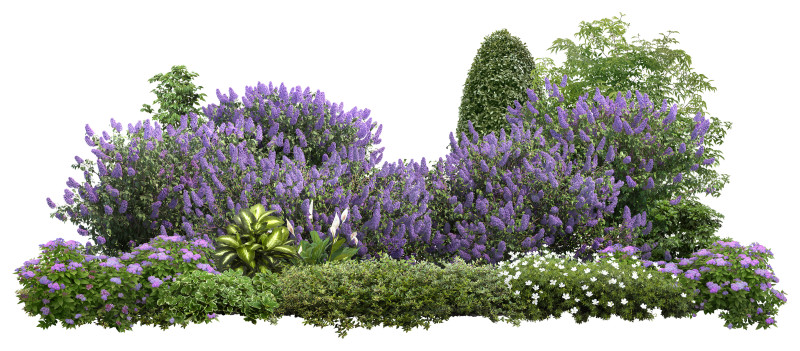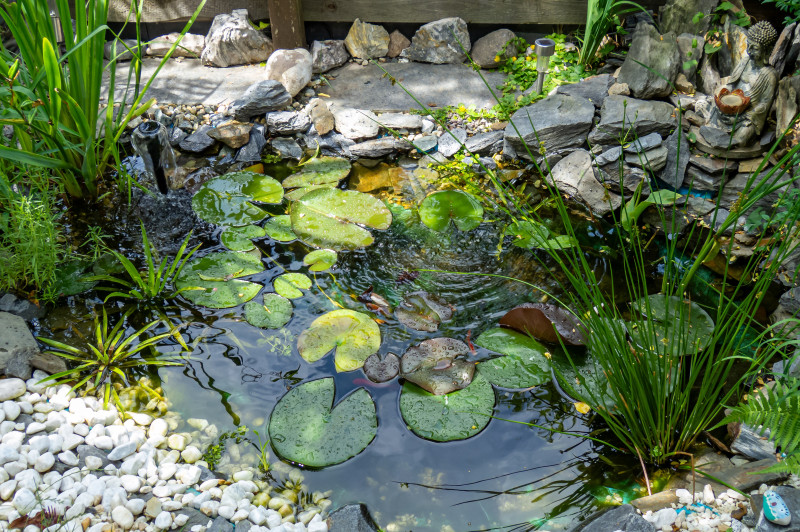Here are more landscape design tips. Think about them as you plan your plantings.
Tips for trees
- Locate large trees away from property lines, phone lines, foundations
- Place some deciduous trees and shrubs on the south of your house to provide shade in summer
- Evergreen trees are helpful on the north and west to serve as windbreaks in winter
- Create several areas of transition—edges—as this is the most active area for wildlife
- Buy trees as large as you can afford and plant them sooner rather than later, as they take much longer to reach maturity
- Leave dead trees, called snags, whether standing or fallen, where they are. Hundreds of species use snags for nesting, resting, and food
- Plant vines and shrubs around snags to hide them
It pleases the eye to:
- Plant a variety of species, but plant them in groups of the same species and colors—it’s also better at catching the eyes of butterflies and hummingbirds
- Plant in groups of odd numbers—3, 5, 7, etc.
- Create a curving pathway through the yard and planted beds—curvy paths add style
- Pathways are convenient for the maintenance of your gardens
Weed barriers
Are you planning to use weed barriers? Landscapers, in particular, make wide use of them, which seems like the perfect solution against weeds. Unfortunately, it isn’t that simple. Plastic barriers aren’t organic and will alter the composition of the soil underneath by killing everything living in it. There are fabric barrier alternatives to that, which allow the ground to breathe. But both types must be covered with mulch to look presentable, and once the mulch decomposes into a layer of “compost,” the weeds will be back. This inescapably leads to the headache of trying to de-weed the area without disturbing the costly underlying barrier. So, why not save the cost of a weed barrier and cover the soil with a 3-inch (7.6 mm) layer of wood mulch?
With mulch, you can hand-weed or use a hoe, as necessary, then cover with a new layer of mulch. Place newspaper (7-9 layers thick) or paper bags under the mulch if you want an additional weed barrier. If you’ll be using an attractive covering of rocks in a planting bed, it makes sense to hold down the weeds by using an underlying weed barrier, but as windblown organic debris decomposes among the rocks, weeds will eventually manage to find a footing.
Mulch
Mulch your planting beds. It dresses up the bare ground, but more importantly, it reduces weeds, cuts down on watering, improves soil quality, prevents erosion, and provides cover for insects.
Mulch needn’t be expensive. Many tree trimmers will gladly deliver a load of tree mulch to your driveway to save them the cost of dumping fees at local landfills. As a matter of fact, they often have waiting lists of people wanting it. (Warning: A full load will be huge, and some trimmers won’t deliver partial ones. Perhaps your neighbors would like to share.)
Mulched leaves and mowed grass also can be used as mulch. Even weeds themselves can become mulch—simply leave them lying on the soil where you pulled them, and don’t cover them with other mulch for several days to ensure they’re completely dead. Note, though: don’t use weeds with seed heads on them. Read about types of mulches here.
Weed control
There’s been much opposition from environmentalists to chemical weed control. Circumstances, however, may sometimes make this the best solution—so long as you use an agent that quickly degrades, such as Round-Up®. This product will kill any foliage it touches and works systemically, only killing the plant it’s sprayed on. There’s no need to spray the soil, as it only works on plants. About 72 hours after use, the plant is dead, and the ground can be safely used for digging and planting. Be sure to read the label carefully, spray only on a day that isn’t windy, and adjust the nozzle so it isn’t emitting a fine mist. Drifting chemicals will kill whatever plant materials they touch. Bayer, the manufacturer, maintains their product is non-toxic to both the environment and humans, but don’t get any on yourself as a safeguard. Some reports suggest that it may cause cancer.
Designing paths and gardens for a backyard wildlife habitat
How to design a backyard wildlife habitat
Look for mulch at home supply and discount stores to save money





